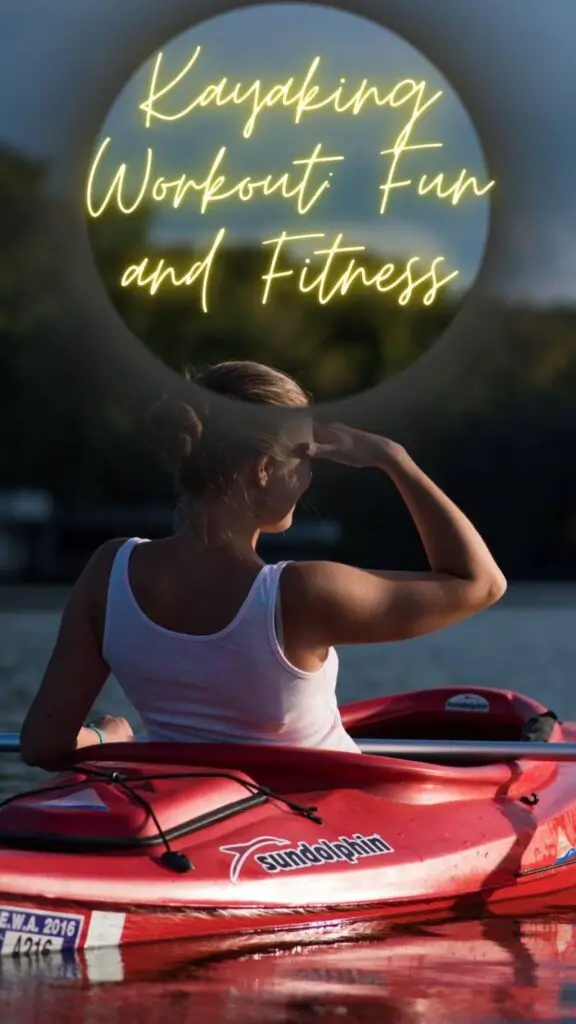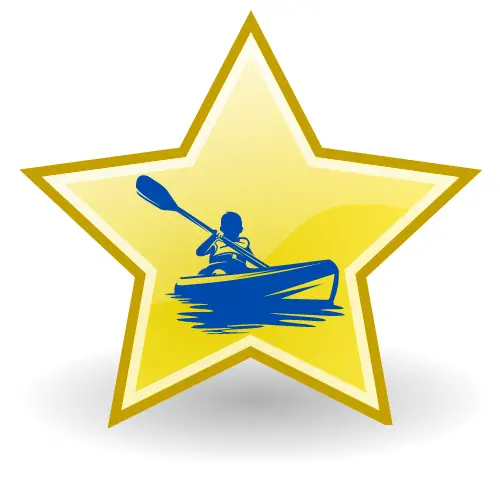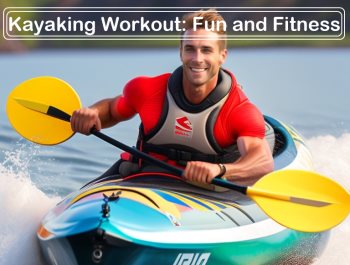Kayaking is not only a recreational activity, but also a fantastic way to stay fit and improve overall well-being. This article explores the various benefits of kayaking as a workout and provides insights into how you can make the most out of this exhilarating water sport.

Table of Contents
Benefits of Kayaking as a Workout
Full-Body Workout
Kayaking engages multiple muscle groups throughout your body, providing a comprehensive full-body workout. With each paddle stroke, you activate your core, back, arms, shoulders, and legs. The repetitive nature of kayaking movements helps tone and strengthen these muscles over time.
Cardiovascular Health
Paddling through the water at a moderate to vigorous intensity increases your heart rate, promoting cardiovascular health. Regular kayaking sessions can improve your endurance, stamina, and lung capacity, leading to a healthier heart and increased overall fitness.
Muscle Strengthening
The resistance offered by the water when paddling creates an excellent opportunity for muscle strengthening. Kayaking targets the muscles in your upper body, including the deltoid, trapezius, biceps, and triceps. Additionally, the lower body muscles such as the quadriceps, glutes, and calf muscles are also engaged during kayaking.
Low Impact on Joints
Unlike high-impact exercises such as running or jogging, kayaking is gentle on your joints. The buoyancy of the water supports your body weight, reducing stress on your knees, hips, and ankles. This makes kayaking an ideal workout for individuals with joint problems or those looking for low-impact alternatives.
Mental Health Benefits
Stress Reduction
Kayaking offers a peaceful escape from the hustle and bustle of everyday life. The serene water, surrounding nature, and rhythmic paddling motion create a calming effect that helps reduce stress and anxiety. Spending time on the water allows you to disconnect from technology and find tranquility in the present moment.
Connection with Nature
Immersing yourself in nature while kayaking can have profound benefits for your mental well-being. The tranquil environment, beautiful scenery, and wildlife encounters provide a sense of connection with the natural world. This connection can bring a feeling of peace, rejuvenation, and a renewed appreciation for the wonders of the outdoors.
Improved Mood and Well-being
Engaging in physical activity releases endorphins, which are known as “feel-good” hormones. Regular kayaking workouts can uplift your mood, boost self-esteem, and contribute to an overall sense of well-being. The combination of exercise, fresh air, and natural surroundings can have a positive impact on your mental health.
Improving Balance and Coordination
Maintaining balance in a kayak requires constant adjustment and coordination of your body movements. As you navigate the water, your core muscles work hard to stabilize your body and keep you upright. Over time, this improves your balance and enhances your coordination skills.
Calorie Burning and Weight Loss
Kayaking is an excellent calorie-burning activity. Depending on factors such as intensity, duration, and your body weight, you can burn approximately 400 to 500 calories per hour while kayaking. Regular kayaking sessions combined with a balanced diet can contribute to weight loss and overall body toning.
Kayaking Workout – Safety Tips
Wearing a Personal Flotation Device (PFD)
Always wear a properly fitting personal flotation device (PFD) when kayaking. A PFD ensures your safety in case of accidental capsizing or unexpected emergencies. It provides buoyancy and helps you stay afloat, especially if you’re not a strong swimmer.
Checking Weather Conditions
Before heading out for a kayaking workout, check the weather forecast and water conditions. Avoid kayaking in severe weather conditions, strong currents, or high winds, as these can pose risks to your safety. Be aware of any potential hazards in the water and plan your outing accordingly.
Paddling Techniques
Learn and practice proper paddling techniques to maximize your efficiency and prevent unnecessary strain or injuries. Use a relaxed grip on the paddle, maintain a straight posture, and engage your core muscles for more effective strokes. Taking lessons or consulting with experienced kayakers can help you improve your technique.
Choosing the Right Kayak and Gear
Selecting the right kayak and gear is crucial for a comfortable and enjoyable kayaking experience. Consider factors such as the type of water you’ll be paddling in, your skill level, and personal preferences. Invest in a kayak that suits your needs and ensure you have essential gear like a paddle, spray skirt, and appropriate clothing for the conditions.
Preparing for a Kayaking Workout
Stretching and Warm-up
Before getting into your kayak, it’s essential to warm up your muscles and perform some stretching exercises. Focus on stretching your arms, shoulders, back, and legs to prepare them for the physical demands of kayaking. A warm-up routine reduces the risk of muscle strains or injuries.
Hydration and Nutrition
Stay hydrated throughout your kayaking workout by carrying an adequate supply of water or sports drinks. Paddling can be physically demanding, and proper hydration is essential for optimal performance. Additionally, fuel your body with a balanced meal or snack before kayaking to ensure you have enough energy to sustain your workout.
Exploring Different Kayaking Environments
Lakes and Ponds
Lakes and ponds provide a tranquil and beginner-friendly environment for kayaking workouts. These calm waters allow you to focus on your paddling technique and enjoy the surrounding scenery. It’s important to be aware of any motorized boat traffic and follow any local regulations or restrictions.
Rivers and Streams
Rivers and streams offer more dynamic and challenging kayaking opportunities. Paddling through flowing water requires increased maneuvering skills and an understanding of river currents. Before attempting river kayaking, ensure you have the necessary experience and knowledge to navigate safely.
Coastal and Ocean Kayaking
Coastal and ocean kayaking provide a unique and exciting experience. However, these environments require advanced skills and knowledge of tidal patterns, currents, and potential hazards such as waves and offshore winds. It’s crucial to have proper training and experience before venturing into open water kayaking.
Kayaking Workouts for Beginners
If you’re new to kayaking, start with shorter sessions and gradually increase your duration and intensity. Begin with calm waters and focus on developing proper paddling technique. Incorporate rest breaks and listen to your body to avoid overexertion or fatigue.
Intermediate and Advanced Kayaking Workouts
As you gain experience and confidence, you can explore more challenging kayaking routes and workouts. Increase your paddling speed, experiment with different strokes and techniques, and challenge yourself with longer distances or more demanding water conditions. Always prioritize safety and be prepared for the challenges of advanced kayaking.
Incorporating Interval Training
To enhance the intensity of your kayaking workouts, consider incorporating interval training. Alternate between bursts of high-intensity paddling and periods of lower intensity or rest. Interval training helps improve cardiovascular fitness, burn more calories, and increase overall endurance.
Joining Kayaking Groups and Clubs
Joining local kayaking groups or clubs can be a great way to connect with like-minded individuals and gain valuable knowledge and experience. These communities often organize group paddles, workshops, and social events, creating a supportive and engaging environment for kayakers of all levels.
Maintaining Proper Form
Maintaining proper form while kayaking is crucial for efficiency, comfort, and injury prevention. Keep your back straight, engage your core muscles, and use a smooth paddling motion. Avoid hunching or straining your neck and shoulders. Regularly check your posture during your workouts to ensure you’re paddling with optimal form.
Conclusion
Kayaking offers a fantastic combination of fun and fitness. It provides a full-body workout, improves cardiovascular health, strengthens muscles, and has numerous mental health benefits. By following safety guidelines, preparing properly, and exploring different kayaking environments, you can enjoy the benefits of this exhilarating sport while staying fit and healthy.
FAQs
Is kayaking suitable for beginners?
Yes, kayaking can be enjoyed by beginners. It’s important to start with calm waters, learn proper paddling techniques, and gradually progress to more challenging environments as your skills improve. Taking lessons or going on guided tours can be helpful for beginners.
Do I need to be a good swimmer to kayak?
While basic swimming skills are beneficial, wearing a personal flotation device (PFD) is essential regardless of your swimming ability. A PFD ensures your safety and buoyancy in case of accidental capsizing.
How many calories can I burn during a kayaking workout?
The number of calories burned during a kayaking workout depends on various factors, including your weight, intensity, and duration of the activity. On average, you can expect to burn around 400 to 500 calories per hour of kayaking.
Can kayaking help with stress relief?
Yes, kayaking can be a great stress-relieving activity. Being surrounded by nature, the rhythmic paddling motion, and the peacefulness of the water can help reduce stress, promote relaxation, and improve overall well-being.
What should I wear for kayaking?
Wear comfortable clothing that allows freedom of movement and protects you from the sun. Consider wearing a moisture-wicking shirt, quick-drying shorts or pants, and water shoes or sandals. Don’t forget a hat, sunglasses, and sunscreen for added sun protection.
Our best posts:

